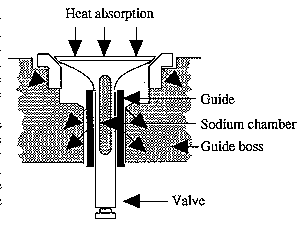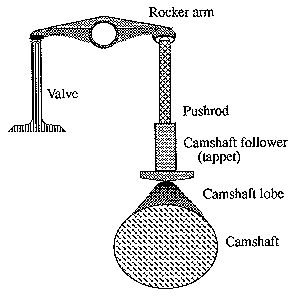 Each cylinder of your piston aircraft enginehas two valves—intake and exhaust—that open and close by slidingin and out through a close-tolerance valve guide. A stuck valveis one that no longer slides readily in its guide. A stuck valvemay refuse to open, or once open it may refuse to close. Eithersituation is quite serious.
Each cylinder of your piston aircraft enginehas two valves—intake and exhaust—that open and close by slidingin and out through a close-tolerance valve guide. A stuck valveis one that no longer slides readily in its guide. A stuck valvemay refuse to open, or once open it may refuse to close. Eithersituation is quite serious.
Stuck valves are usually caused by a build-up of deposits and/orcorrosion on the valve stem. Because the fit of the stem in theguide is so snug, it doesn’t take much build-up on the valve stemto interfere with free movement of the valve within the guide.
"Morning sickness"
The clearance between the valve stem and its valve guide are ata minimum when the engine is cold. Consequently, the first signof a stuck valve usually occurs when the engine is first started,and is often identified by an intermittent hesitation, or miss,in engine speed. We call this "morning sickness".
Morning sickness is a warning that should be heeded immediately.Sticky valves never get better by themselves…they always getworse, usually fairly quickly. Flying an airplane whose engineexhibits morning sickness increases the risk of serious enginedamage and possibly in-flight engine failure. Hence, the aircraftshould be downed for maintenance at the first hint of valve sticking.
What makes valves stick?
Valve sticking is influenced both by the design of the engineand the environment in which it is operated. Lycomings have morevalve sticking problem than Continentals. Hot-running enginesstick valves more often than cool-running ones. Valves are morelikely to stick in hot summer weather than in cold winter months.The use of heavily-leaded fuels and inadequate leaning can leadto valve sticking, as can infrequent oil changes.
Heat is the primary cause of valve sticking. High temperaturesin the exhaust valve guide oxidizes oil and forms carbon depositson the valve guide, and these deposits can cause the valve tostick. The most frequent reason for elevated valve temperaturesis valve leakage.
All of the combustion gas must pass around the valve face as itgoes out the exhaust port. The large heat-absorbing surface ofthe exhaust valve face must conduct heat away from its surface.A valve that is not contacting its seat properly (i.e., is leaking)cannot conduct as much heat into the cylinder head as a valvewith good seating.
Sticky Lycomings
Lycoming valve stems operate at higher temperatures than Continentalvalves stems. Continental engines use solid exhaust valves whereasLycoming engines use sodium-cooled exhaust valves, which havehollow stems filled with metallic elemental sodium. The sodiumin the Lycoming valve melts at 97.5°C and conducts heat fromthe valve head into the valve stem, where it is conducted throughthe valve guide into the cylinder head. The Lycoming valve stemnormally operates 100°F hotter than the Continental valvestem. The higher valve stem temperatures in Lycomings make themmore susceptible to valve sticking.
 Most of the heat conducted from the head of the Lycoming exhaust valvegoes out though the valve stem into the cylinder head fins. Inaddition, the Lycoming guide boss allows 5% of the guide to extendpast the end of the boss and protrude into the exhaust port. Theprotruding guide absorbs heat from the flow of exhaust gas. Becauseof the high temperatures and combustion deposits on the exhaustvalve stem, this area of the guide "bell mouths" orgets bigger. This increases the clearance between the guide andthe stem and allows combustion products and heat to travel upthe valve stem. These combustion products create lead depositsand acids which increase the corrosive environment.
Most of the heat conducted from the head of the Lycoming exhaust valvegoes out though the valve stem into the cylinder head fins. Inaddition, the Lycoming guide boss allows 5% of the guide to extendpast the end of the boss and protrude into the exhaust port. Theprotruding guide absorbs heat from the flow of exhaust gas. Becauseof the high temperatures and combustion deposits on the exhaustvalve stem, this area of the guide "bell mouths" orgets bigger. This increases the clearance between the guide andthe stem and allows combustion products and heat to travel upthe valve stem. These combustion products create lead depositsand acids which increase the corrosive environment.
Lycoming valves also stick because of corrosion buildup on thevalve stem. Corrosion increases the diameter of the valve , therebyreducing the valve stem-to-guide clearance. The high stem temperatures,combined with a design which allows more combustion products intothe guide bore, create a corrosive environment which is seldomseen on Continental engines.
Lycoming TIO-541 engines installed in the Beechcraft Duke usean oil-cooled exhaust guide. Cooling oil circulates in a groovebetween the exhaust guide and the guide boss. If this groove cokesup with oxidized oil and becomes blocked, the exhaust guide andvalve overheat and stick. If you have a stuck exhaust guide onthis engine, be sure to check the oil passage by blowing compressedair through the oil fitting in the cylinder head.
Continental engine design is more resistant to valve sticking.Big-bore Continentals rarely stick valves. We do see a tendencyfor intake valves to stick on Continental engines in the O-200,O-300 series. A stuck intake valve disrupts the breathing of theentire induction system. The power loss results in a forced landing.
Engine operating environment
Environmental influences that create valve sticking are: hightemperatures, dirty oil, high-lead fuels, hot engine shut-downs,and poor engine baffling. Improper leaning can also be a culprit:an engine that is run excessively rich will build up carbon, lead,and other combusion-related deposits on exhaust valve stems morequickly. On the other hand, an engine that is leaned excessivelyduring high-power operation will experience high valve temperatures,and this contributes to valve sticking.
Engine overhaul shops can’t do much to prevent valve sticking.They cannot change the engineering of the engine, and have littlecontrol over its operating environment. About all they can dois to use the correct parts (valves, guides, seats, rotators,etc.), to dimensionally match the parts carefully, and to controlthe surface finish of the guide by careful reaming and honing.
Your regular maintenance shop can influence the operating environmentby checking the engine’s health regularly (via compression checks,oil analysis, filter inspection, etc.), by making sure the coolingbaffles are in good shape and the magneto timing is correct, andby changing the oil frequently.
What happens whan a valve sticks?
When an engine has a stuck valve, one of five things can happen,each of which is bad news:
The pushrod bends.
The surface of the camshaft or cam follower fails.
The valve opens but won’t close.
The rocker support breaks.
The valve rotator cap falls off the end of the valve stem. (Lycomingsonly.)
 A valve that sticks closed will often result in serious and costlyengine damage. Each time the cam-tappet-pushrod-rocker try toopen that stuck valve, you risk catastrophic engine damage. Witha stuck valve, the valve doesn’t want to move. Tremendous valvetrain forces develop as the camshaft lobe tries to force the valveopen. The camshaft follower and lobe are the most highly-stressedcomponents of the engine even under normal conditions…the additionalloading caused by a stuck valve may induce catastrophic failureof the rocker support, pushrod, cam follower, or cam lobe.
A valve that sticks closed will often result in serious and costlyengine damage. Each time the cam-tappet-pushrod-rocker try toopen that stuck valve, you risk catastrophic engine damage. Witha stuck valve, the valve doesn’t want to move. Tremendous valvetrain forces develop as the camshaft lobe tries to force the valveopen. The camshaft follower and lobe are the most highly-stressedcomponents of the engine even under normal conditions…the additionalloading caused by a stuck valve may induce catastrophic failureof the rocker support, pushrod, cam follower, or cam lobe.
A damaged camshaft lobe requires complete engine removal and teardown.The same is true of a damaged cam follower if it is the mushroom-headvariety used in many Lycoming engines.
Sometimes an exhaust valve that is stuck closed can causethe intake pushrod to bed or the intake rocker supportboss to break. How can this happen? If the exhaust valve sticksclosed, exhaust gases will not exit from the cylinder. Gas pressurewithin the cylinder then prevents the intake valve from opening.If this happens, something’s gotta give. Either the pushrod bendsor the rocker support breaks.
You might think that a valve that sticks open is a much less serioussituation, but that’s not necessarily so. If the valve is an intakevalve, you lose power and will need to make a forced landing.If the valve is an exhaust valve, there will not be any compressionon that cylinder.
In either case, if the valve spring can’t close the valve, theentire valve train (cam follower, pushrod, and rocker arm) unloads.The end of the pushrod that rests in the socket in the cam followermay come out of the socket and fling around inside the tappetboss. If the pushrod ball does not locate itself back into thesocket when the cam lobe comes around, it may jam against thetappet housing, usually causing crankcase damage.
The valve rotator cap on Lycoming engines is kept on the tip ofthe exhaust valve stem by the rocker arm. If the valve sticksopen, the rocker may move far enough away to allow the rotatorcap to fall off the valve stem tip. When this happens, not onlyis valve clearance excessive, but also the rocker face poundsinto the spring seat. The rotator cap is too big to fall downthe pushrod tubes. It just lays in the rocker box until you takethe rocker box off. It then quietly falls unnoticed onto the hangarfloor. If you notice a missing rotator cap, it is likely thatthe exhaust valve was stuck open in the past. Look in the rockerbox or around the hangar floor and you might find it.
Engine damage does not always occur when the valve sticks, butthe longer the engine operates in this condition, the greaterthe chances are that some damage will occur.
Remedial action
Repairing a stuck valve can be done without removing the cylinderfrom the engine. The procedure is described in Lycoming ServiceInstruction 1425 and consists of dropping the valve into the combustionchamber, reaming the guide, and then reinstalling the valve.
Another method is to tie dental floss to the end of the exhaustvalve and lower it down into the cylinder. Ream the guide andthen pull the valve back up into the guide.
If it’s necessary to remove the cylinder, we recommend you inspectthe condition of the camshaft lobes and the cam follower. Youmay want to review the operating environment of the engine. Payparticular attention to the oil change intervals, baffle condition,and operating techniques.
The procedure outlined in Lycoming Service Instruction 1425 anddescribed here can also be used on Continental engines.
Do not use Marvel Mystery Oil or other solvents to un-stick avalve. Solvents may un-stick the valve in time but not immediately.Eventually the valve may un-stick, but not before your camshaftlobes have been damaged.
Solvent treatments dissolve the outer deposit layers in the guideboss and temporarily un-stick the valve. The remaining depositspush the valve over to the opposite side of the guide and causerapid, uneven guide wear. The valve stem may stick or it may causerapid guide wear where the stem is forced against the guide materialopposite of the deposit buildup.


































